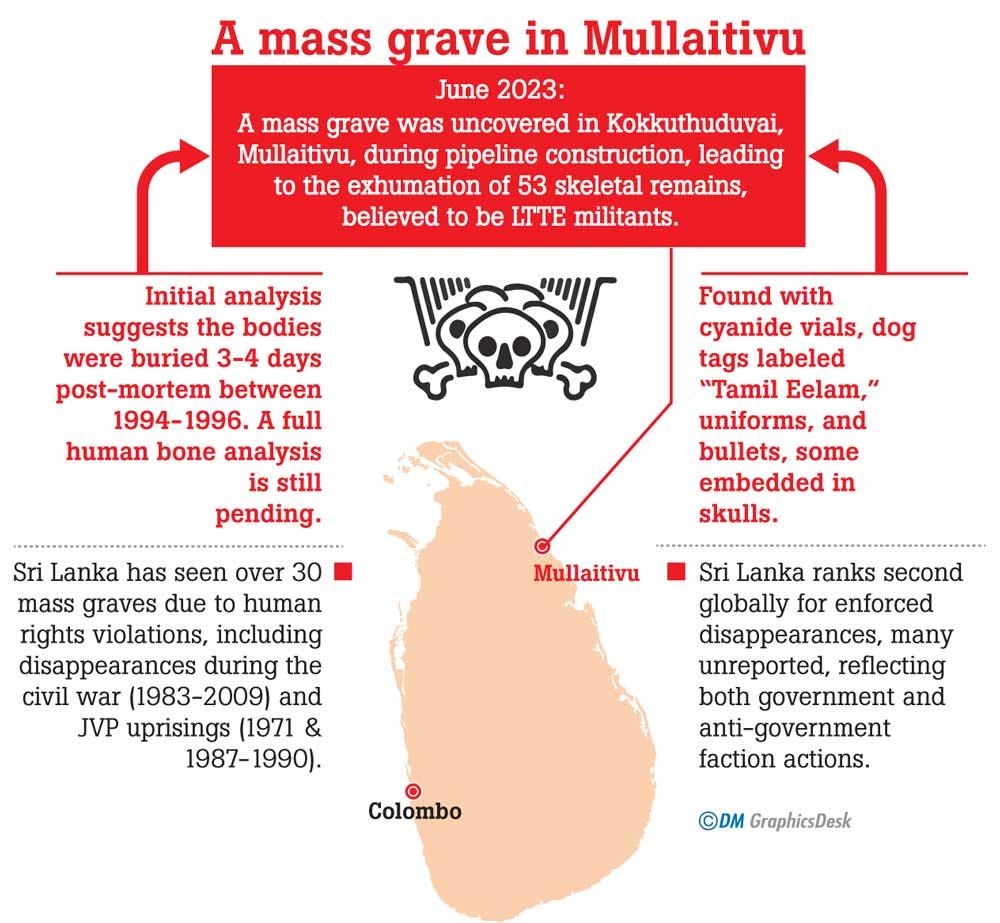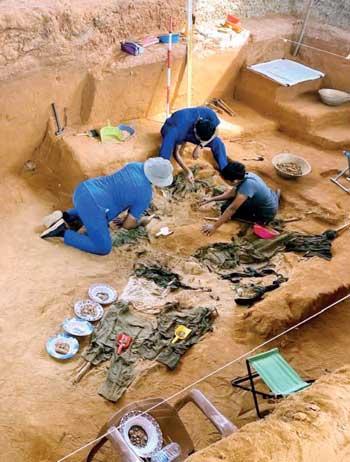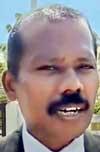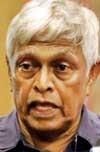16 Oct 2024 - {{hitsCtrl.values.hits}}

 Time and time again, there comes a murmur of yet another mass grave having been discovered in the island. These chance discoveries occur most often during construction of buildings or when laying underground pipelines for water supply. The skeletal remains get exhumed, are used in several court proceedings and thereafter the murmur becomes a whisper which eventually gets buried in the barrage of other news that takes precedence.
Time and time again, there comes a murmur of yet another mass grave having been discovered in the island. These chance discoveries occur most often during construction of buildings or when laying underground pipelines for water supply. The skeletal remains get exhumed, are used in several court proceedings and thereafter the murmur becomes a whisper which eventually gets buried in the barrage of other news that takes precedence.
 |
| The skeletal remain and artefacts being excavated by forensic archeologists from the mass grave site in Kokkuthuduvai, Mullaitivu – (Photo credits: Office of Missing Persons) |
While the identities of the skeletons being unearthed at the mass grave at Colombo Port Premises remain a mystery, those of the 53 skeletal remains at the Kokkuthuduvai, Mullaitivu mass grave were rather clear from the inception. The vials of cyanide, dog tags with inscriptions of Tamil Eelam, and the uniforms gave clear clues of the victims’ identities.
Unearthing the grave site
The mass grave in Mullaitivu was uncovered in late June 2023, along the Kokkuthuduvai-Kokkilai road. It was accidentally uncovered when municipal workers were laying pipelines for water supply. Having found bones with articles of clothing in the trench subsequently led to a full-scale excavation.
Forensic Archeologist Prof. Raj Somadeva, who oversaw the exhumation of the skeletal remains and other artefacts in this grave site, told Daily Mirror last week that the burial at this mass grave seemed to be of a ‘military type’. Adding that the victims were militants of the Liberation Tigers of Tamil Eelam (LTTE), Prof. Somadeva said that they also discovered various artefacts in the trench such as cyanide tubes, uniforms, bullets, and dog tags bearing inscriptions like “Tamil Eelam” and other acronyms. He also noted that bullets were found in some skulls.
Prof. Somadeva further said, “According to our understanding, they had been buried by someone or some organisation 3-4 days after they died.” According to him, the victims had been buried between 1994-1996. However, it is understood that a human bone analysis report will be required to confirm the actual period in which the burials were carried out, including other information such as cause of death.

“There is a need for those who know about those numbers to inform them to the court registrar. Initially the complete set of reports of the grave site and the analysis of the remains should be submitted to court”
- Vallipuram Santhirapragasam Niranjan, Lawyer

The dog tags may facilitate in identifying the remains that were exhumed from the Mullaitivu mass grave. The numbers given (on the uniforms or dog tags) are known to the families– therefore the identification of the remains has to be done using these. But, we also don’t know whether the family members of all victims are alive
- Ranitha Gnanarajah, HR Activist and Lawyer representing families of disappeared
in the same case

There are so many things that they (the government) try to conceal. Most of the commission reports on disappearances are not published. The previous governments didn’t want to make these things public. The new government for which many Sinhala youth sacrificed their lives in 1971 and 1989 should make these things public
- Brito Fernando, HR Activist and President of the Families of the Disappeared Organisation
While there were conflicting reports on the actual number of skeletal remains found in this grave site, Prof. Somadeva confirmed that 53 skeletal remains were exhumed.
The archeology report of the findings was recently submitted to the Mullaitivu Magistrate Court.
While there were claims that all or the majority of skeletal remains found in this grave were of females, it is learned that a human bone analysis report is required to confirm the same.
Identification of victims
After the conclusion of the recent hearing of this case on September 24, Vallipuram Santhirapragasam Niranjan, a lawyer representing the families of disappeared, addressed media representatives outside the Mullaitivu Magistrates Court. He revealed that the LTTE dog tags and numbers on the uniforms that had been recovered from the mass grave had been submitted to court by the Judicial Medical Officer (JMO).
Speaking further, Niranjan noted that the Court had informed that the numbers displayed on the uniforms should be made available to the public ‘in due course’ to aid in identification of the victims. “There is a need for those who know about those numbers to inform them to the court registrar. Initially the complete set of reports of the grave site and the analysis of the remains should be submitted to court,” said Niranjan. The next hearing is scheduled for December 12, 2024. . It should be underscored that if the numbers on the uniforms and dog tags are released to the public in due course it would mark a significant first for Sri Lanka says Ranitha Gnanarajah Human Rights Activist and Lawyer representing the families of disappeared in the same case.
The application to make the numbers public had been made by the Office of Missing Persons.
In response to a question posed by the Daily Mirror, Gnanarajah said that in previous mass graves, specifically those in the north and east where excavation was complete, the identification of the victims and further information calling from the public had not begun to date.
“The dog tags may facilitate in identifying the remains that were exhumed from the Mullaitivu mass grave. The numbers given (on the uniforms or dog tags) are known to the families– therefore the identification of the remains has to be done using these. But, we also don’t know whether the family members of all victims are alive,” Gnanarajah said.
She also emphasised that the families of the disappeared in the Mullaitivu District participated in the process of monitoring the excavation. They are also taking part in the court proceedings.
While it is given that victims were LTTE militants, the general attitude of many, if not most, would be that of dismissal or nonchalance as the victims are considered ‘terrorists’. “Whatever it is, they are someone’s children and belong to some family. Death is something we cannot celebrate or consider a victory. Even if they (the victims) are of the military, we have to show respect for the dead. Showing hatred and ignorance isn’t going to accomplish anything. Whether it’s the LTTE or the military shouldn’t concern us when it comes to death. We have to look at it from a humanitarian perspective,” Gnanarajah shared.
Meanwhile, President of the Families of the Disappeared Organisation and Human Rights Activist, Brito Fernando, stressed that the identities of the victims should be made public. “There are so many things that they (the government) try to conceal. Most of the commission reports on disappearances are not published. A letter sent by 4 UN rapporteurs inquiring about Gotabaya Rajapaksa’s role in the disappearance of about 70 people in 1989 from Matale was not answered for about 2 years. The previous governments did not want to make these things public. The new government for which many Sinhala youth sacrificed their lives in 1971 and 1989 should make these things public,” he said.
Returning remains to families
Mass grave sites, unfortunately, are not new to Sri Lanka. But with over 20 — some reports even suggest more than 30 — mass graves discovered across the country, the Daily Mirror asked Gnanarajah if skeletal remains have ever been returned to family members. “So far in the history of the post-conflict scenario, skeletal remains (exhumed from mass grave sites) have never been returned to families. Nothing has been done in terms of releasing or handing over the remains that have been identified in different mass graves. Even the skeletal remains found in the mass grave in Matale are at the JMO’s premises,” she explained.
The mass grave in Matale was discovered in 2012 where a total of 155 skeletal remains were exhumed. According to the archeological report by Prof. Somadeva, the remains found indicated the use of firearms and blunt instruments, with iron nails being driven into skulls and signs of decapitation. Based on some artefacts found among the remains, Somadeva concluded they dated from the late 1980s.
With the remains exhumed from mass graves not identified and thereby not returned to the families, they continue to be shelved at the premises of the JMO.
More reports required to learn about victims
Whilst the archeology report on the Kokkuthuduvai, Mullaitivu grave site has already been submitted to court, additional reports are required to gain a clearer understanding about the grave site and the victims, such as the ages, sex, when they died and the cause of death.
According to Gnanarajah, the bone analysis report is being prepared by Dr. S. Pranavan at the Jaffna Medical Faculty. She added that the reports from the Scene of Crime Officers (SOCO), as well as geology and soil analysis are also required.
Enforced disappearances
Each skeletal remain lying beneath a mass grave site or shelved at the premises of the JMO could belong to someone whose family still clings to the hope of the return of a loved one. Tragically, some parents have passed away waiting for any news about their child—after all, it is unlikely that their child simply vanished into thin air.
Sri Lanka ranks second globally in enforced disappearances, based on complaints reported to the United Nations (UN) Working Group on Enforced or Involuntary Disappearances. However, there is reportedly substantial evidence to suggest that there are thousands more cases of enforced disappearances that have not been accepted by any police station or reported to the various commissions appointed in the country from time to time. The disappearances of thousands of people, allegedly by the Government and associated military groups, occurred predominantly during the Janatha Vimukthi Peramuna (JVP) uprising of 1971 and its insurgency in the late 1980s, the riots of 1983, and during and after the civil war. During the final stages of the civil war, many people disappeared—some at the hands of the Liberation Tigers of Tamil Eelam (LTTE), others by security forces and paramilitary groups. However, these disappearances did not end with the conclusion of the war. A significant number of disappearances have been reported since 2009.
The report titled ‘Mass graves and failed exhumations in Sri Lanka’ released in June 2023 states that the remains exhumed in the south of the country reveal widespread violations, notably enforced disappearances by government forces against armed insurgents of the Janatha Vimukthi Peramuna between 1987 and 1990. Others exhumed in the north and east are a stark reminder of the widespread and systematic human rights violations committed by the security forces during the 1983-2009 armed conflict with the LTTE. It adds that other mass graves, like one in Kaluwanchikudy, Batticaloa district, contain as yet unexhumed skeletal remains of people killed by the LTTE.
These chance discoveries suggest human rights violations by the government and associated military groups, or by anti-government factions. Thus far, about 22 mass graves have been exhumed. Meanwhile, a total of 32 mass grave sites have been discovered between 1992 and 2022 (as per a report titled ‘Mass graves in Sri Lanka: History and Legal Framework’ by Sophie Bisping published in 2023).
23 Dec 2024 7 hours ago
23 Dec 2024 8 hours ago
23 Dec 2024 23 Dec 2024
23 Dec 2024 23 Dec 2024